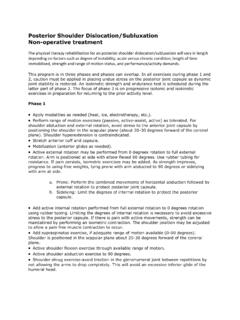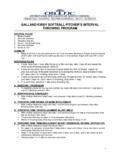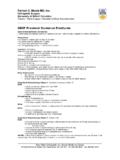Transcription of Anterior Shoulder Dislocation/Subluxation Non …
1 Anterior Shoulder Dislocation/Subluxation Non- operative treatment The physical therapy rehabilitation for an Anterior Shoulder Dislocation/Subluxation will vary in length depending on factors such as degree of instability, acute versus chronic condition, length of time immobilized, strength and range of motion status, and performance/activity demands. This program is in three phases and phases can overlap. In all exercises during phase 1 and 2, caution must be applied in placing undue stress on the Anterior joint capsule as dynamic joint stability is restored. An isokinetic strength and endurance test is scheduled during the latter part of phase 2. The focus of phase 3 is on progressive isotonic and isokinetic exercises in preparation for returning to the prior activity level. Phase 1 Apply modalities as needed (heat, ice, electrotherapy, etc.)
2 Perform range of motion exercises (passive, active-assist, active) as tolerated. For Shoulder abduction and external rotation, avoid stress to the Anterior joint capsule by positioning the Shoulder in the scapular plane (about 20-30 degrees forward of the coronal plane). Shoulder hyperextension is contraindicated. Stretch posterior cuff and capsule. Mobilization (posterior glides as needed). Active Shoulder internal/external rotation exercises with rubber tubing. Arm positioned at the side with elbow flexed 90 degrees. Avoid excessive stress to the Anterior joint capsule by limiting external rotation to no greater than a 45 degree range (as tolerated). If discomfort persists, isometric exercises may be added. The Shoulder position may be adjusted to allow a pain free muscle contraction to occur.
3 Add supraspinatus exercise in the scapular plane if adequate range of motion is available (0-90 degree range). Active Shoulder flexion exercise through available range of motion. Active Shoulder abduction exercise to 90 degrees. Maintain Shoulder in the scapular plane to avoid stress on the Anterior joint capsule. Shoulder extension exercise-lying prone or standing (bending at the waist). Avoid the Shoulder extended position by preventing arm movement beyond the plane of the body. This will decrease excessive stress to the Anterior joint capsule. Shoulder shrug exercise-avoid traction in the glenohumeral joint between repetitions by not allowing the arms to drop completely. This will avoid an excessive inferior glide of the humeral head. Avoid horizontal adduction exercise-perform supine with the starting position in the scapular plane.
4 Active Shoulder internal/external rotation-progress to free weights. Shoulder internal rotation: perform sidelying with the involved side resting on the plinth. Elevate or support the lateral chest wall (pillow, bolster, etc) to decrease the joint compression on the involved Shoulder . Shoulder external rotation: lie on the uninvolved side. Avoid excessive stress to the Anterior joint capsule by limiting movement to no greater than 45-50 degrees of external rotation. Add forearm strengthening exercises (elbow and wrist). Phase 2 Continue posterior cuff/capsule stretch, mobilization, and range of motion exercises Continue Shoulder strengthening with tubing and/or free weights. Emphasize eccentric phase of contraction. Add arm ergometer for endurance exercise. Add push-ups. Maintain proper alignment of the shoulders and elbows at the starting position.
5 Caution is applied during the descent phase of the push-up to avoid excessive stress to the Anterior capsule. Do not lower the body beyond the elbows. Begin with wall push-ups. As strength improves, progress to floor push-ups as tolerated. Isokinetic test. Perform isokinetic strength and endurance test for the following suggested patterns: Shoulder internal/external rotation (arm at side), abduction/adduction, and flexion/extension as tolerated. To perform test, prerequisite strength requirements of the rotator cuff are 5-10 ponds for external rotation and 15-20 pounds for internal rotation. The Shoulder should be pain free and have no significant amount of swelling. Add isokinetic strengthening and endurance exercises (high speeds-200 plus degrees/sec) for Shoulder internal/external rotation with arm at the side.
6 Maintain Shoulder in 15-20 degrees of flexion and limit external rotation to 45-50 degrees to avoid excessive stress to the Anterior joint capsule. Add total body conditioning with emphasis on strength and endurance, including flexibility exercises as needed. Phase 3 Continue posterior cuff/capsule stretching (as needed). Continue to emphasize the eccentric phase in strengthening the rotator cuff. Continue to progress to isotonic and isokinetic exercises. For Shoulder internal/external rotation, gradually increase the stress to the Anterior joint capsule by positioning the upper extremity at 45 degrees external rotation and 80-90 degrees of abduction. Continue to exercise in the functional Shoulder position specific to the sport tolerated. Add isokinetic exercises for Shoulder flexion/extension, abduction/adduction, and horizontal abduction/adduction.
7 Take precautions in avoiding excessive stress to the Anterior joint capsule. Add chin-ups, military press, and continue arm ergometer for endurance. The second isokinetic test is administered for Shoulder internal/external rotation, abduction/adduction, and flexion/extension. For Shoulder IR/ER, the Shoulder may be tested in the functional position (80-90 degrees abduction). Test results should demonstrate at least 80% strength and endurance (as compared to opposite side) before proceeding with exercises specific to the activity setting. Continue total body conditioning program. Skill mastery. Begin practicing skills specific to the activity (work, recreational activity, sport, etc). For example, throwing athletes may proceed to throwing program.




